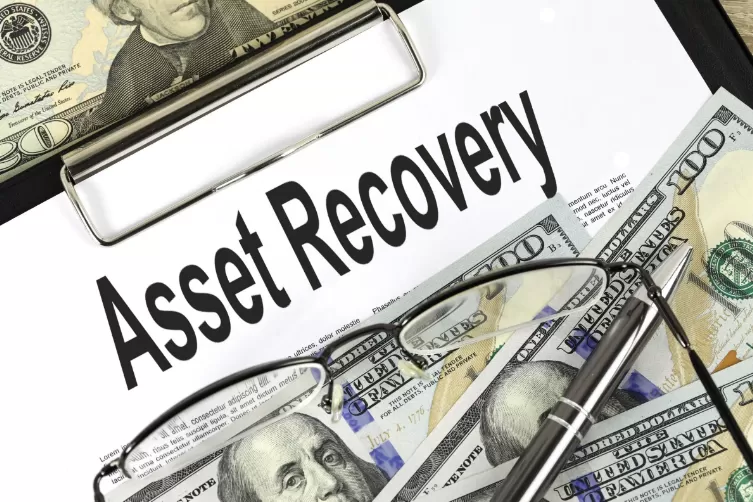Written By:
Scott McAuley
Scott is the IT Director of Texas Management Group, and has been in the IT industry for 25 years.
As a business owner, investments are crucial to the success and growth of your company. However, investments may sometimes be lost or stolen, which can significantly impact your business’s bottom line. This is where asset recovery comes in.
Asset recovery is the process of identifying and recovering lost or stolen assets, transforming liabilities into valuable resources that can benefit your company. By salvaging your business investments, you can optimize your returns and ensure the growth and sustainability of your business.

Key Takeaways:
- Asset recovery transforms liabilities into valuable resources by recovering lost or stolen assets, optimizing business returns, and supporting growth and sustainability in a competitive environment.
- Asset recovery involves steps like identifying, locating, and retrieving assets using initiatives like the Stolen Asset Recovery Initiative, mutual legal assistance, and international cooperation to combat illicit asset transfers.
- Effective asset recovery relies on global cooperation between countries, law enforcement, and organizations like the UNODC and FATF, promoting transparency and technical assistance in recovering stolen assets.
- Law enforcement, asset recovery offices, and financial intelligence units collaborate to identify, trace, and seize illicit assets, enhancing the success of recovery efforts through shared resources and expertise.
- Despite challenges like complex financial structures and jurisdictional issues, effective asset recovery offers significant benefits, including financial restitution, deterrence of illicit activities, and promotion of good governance.
Table of Contents
Understanding the Asset Recovery Process
Asset recovery is the process of identifying, locating, and recovering stolen or lost assets. It involves a series of steps aimed at recovering assets that have been illegally obtained or transferred.
In this section, we will delve into the asset recovery process, including the stolen asset recovery initiative, mutual legal assistance, and the role of civil society and international cooperation in asset recovery efforts.
The Stolen Asset Recovery Initiative
The Stolen Asset Recovery Initiative (StAR) was launched in 2007 by the World Bank and UNODC to support international efforts to recover assets that have been stolen by corrupt officials and transferred to foreign jurisdictions.
The initiative provides a platform for countries to work together to recover stolen assets through mutual legal assistance, capacity-building, and other forms of cooperation.
Mutual Legal Assistance
Mutual legal assistance is a key component of the asset recovery process. It involves cooperation between civil society organizations and countries to gather evidence, locate assets, and facilitate the transfer of assets to the country of origin.
Mutual legal assistance is crucial in cases where assets have been transferred to foreign jurisdictions, as it enables countries to work together to recover those assets.
The Role of International Cooperation
International cooperation is essential in successful asset recovery efforts. This includes cooperation between law enforcement authorities, asset recovery offices, and financial intelligence units across different countries.
International organizations such as the Financial Action Task Force (FATF) and the United Nations Office on Drugs and Crime (UNODC) also play a vital role in facilitating international cooperation and providing technical assistance to countries.
Overall, the asset recovery process involves a complex series of steps aimed at recovering stolen or lost assets. The stolen asset recovery initiative, mutual legal assistance, and international cooperation are key components that help facilitate successful asset recovery efforts.
Key Players in Asset Recovery
Asset recovery involves several key players, including law enforcement authorities, asset recovery offices, and financial intelligence units.
Law enforcement authorities play a crucial role in asset recovery efforts. They are responsible for conducting investigations, gathering evidence, and prosecuting individuals or entities involved in illicit activities. These authorities can also freeze and seize assets that have been obtained through illegal means.
Asset recovery offices, on the other hand, are specialized units that focus on recovering stolen or misused criminal assets. They work closely with law enforcement authorities and other relevant agencies to identify and locate these assets.
Asset recovery offices may also negotiate with other countries to obtain mutual legal assistance or to repatriate assets that were moved across borders.
Financial intelligence units (FIUs) are responsible for collecting, analyzing, and disseminating financial information related to criminal activities. They work with law enforcement authorities and asset recovery offices to identify and trace the movements of illicit funds and assets.
FIUs also monitor financial transactions for suspicious activities and can provide valuable information to support investigations into asset recovery.

The cooperation between these key players is essential for the success of asset recovery efforts. By working together, law enforcement authorities, asset recovery offices, and financial intelligence units can pool their resources and share information to identify and recover stolen or misused assets.
International Efforts and Initiatives
Asset recovery is a global issue, and as such, international efforts and initiatives have been established to facilitate cross-border cooperation and collaboration. These efforts are primarily spearheaded by international organizations such as:
- The World Bank
- The Financial Action Task Force (FATF)
- The United Nations Office on Drugs and Crime (UNODC)
These organizations work together with priority countries to develop policies and guidelines aimed at improving asset recovery efforts. They also offer technical assistance and training to these countries to build capacity and enhance their ability to identify, trace, and recover stolen assets.
The World Bank has developed a Stolen Asset Recovery Initiative (StAR) that provides guidance and support to countries in their efforts to recover stolen assets. The initiative offers a wealth of resources, including research papers, reports, and toolkits designed to assist countries in identifying and tracing stolen assets.
The FATF is an intergovernmental organization that develops policies to combat money laundering and terrorist financing. The FATF has established a set of standards that countries must adhere to in their asset recovery efforts.
These standards include measures aimed at improving transparency and enhancing international cooperation in the fight against asset theft.
The UNODC plays a crucial role in the global fight against organized crime. The organization provides technical support to countries in their efforts to address crime and the proceeds of corruption, including asset recovery.
The UNODC has also developed a Global Programme against Money Laundering, Proceeds of Crime and the Financing of Terrorism, which provides a framework for countries to enhance their asset recovery efforts.

Through these initiatives, international organizations are working together with governments and law enforcement agencies to improve asset recovery efforts and tackle the issue of illicit financial flows.
However, despite these efforts, there are still challenges that need to be addressed to ensure effective asset recovery on a global scale.
Challenges and Benefits of Asset Recovery
Asset recovery efforts can be an uphill battle, especially when it comes to identifying and recovering illicit assets.
This is particularly true for developing countries, where resources are often limited, and corruption can hinder the effective implementation of asset recovery. Despite these challenges, there are several benefits to implementing good practices in asset recovery.
Challenges
The challenges of asset recovery include the difficulty in identifying and tracing illicit assets, especially when they are hidden in complex financial structures. This is further compounded in developing countries where legal frameworks may be weak, and government corruption can hinder investigations.
There may also be challenges in recovering confiscated assets, particularly when they are located in a different jurisdiction or have been converted into other forms of property. Communication breakdowns and lack of cooperation between agencies can also slow down asset recovery efforts.
Benefits
Despite these challenges, there are several benefits to effective asset recovery. Recovering stolen assets can bring significant financial benefits to a company, helping to offset losses and improve overall financial well-being.
Additionally, effective asset recovery can help to deter future fraudulent activity by sending a strong message that such behavior will not be tolerated.
Implementing good practices in asset recovery can also improve a company’s reputation and increase public trust. Finally, asset recovery efforts can have a positive impact on developing countries by reducing corruption and promoting good governance.
Good Practices
Implementing good practices in asset recovery is crucial to overcoming its associated challenges. This includes developing a comprehensive legal framework and policies that are in line with international standards, such as the GFAR principles and FATF standards.
It also involves establishing competent authorities and national authorities who are responsible for facilitating asset recovery efforts. Finally, conducting thorough financial investigations and effective communication between agencies are essential for successful asset recovery.

Overall, asset recovery can be a challenging but rewarding process. By implementing good practices, companies can realize the benefits of recovering stolen assets while also promoting good governance and deterring future fraudulent activity.
Legal Framework and Policies for Asset Recovery
Asset recovery efforts rely on a strong legal framework and policies that can facilitate cooperation between competent authorities and national authorities.
The criminal justice system plays a critical role in ensuring that asset recovery efforts are successful. Criminal convictions provide a legal basis for the confiscation of illicit assets, making it easier for law enforcement agencies to trace and recover them.
The GFAR (Global Forum on Asset Recovery) principles provide guidance on how governments can effectively manage the return of stolen assets. These principles cover key areas such as international cooperation, transparency, and good governance.
The FATF (Financial Action Task Force) standards provide a framework for combating money laundering and terrorist financing. These standards include recommendations on confiscation and asset recovery, which can help countries develop effective policies and procedures.
| Legal Framework and Policies for Asset Recovery | Description |
|---|---|
| Competent authorities | The authorities responsible for carrying out asset recovery efforts, including law enforcement agencies, prosecutors, and judges. |
| National authorities | The authorities responsible for developing policies and procedures for asset recovery, including financial intelligence units and regulatory bodies. |
| Criminal conviction | A legal basis for seizing and confiscating illicit assets. Criminal convictions provide a framework for asset tracing and recovery efforts. |
| GFAR principles | Guiding principles for asset recovery efforts that promote international cooperation, good governance, and transparency. |
| FATF standards | Recommendations for combating money laundering and terrorist financing, including guidelines for asset recovery and confiscation. |
Developing effective policies and procedures for asset recovery requires a thorough understanding of the legal framework and the role of competent and national authorities. Countries need to establish clear policies and procedures that are consistent with international standards and that can facilitate asset recovery efforts.

By aligning policies and procedures with GFAR principles and FATF standards, countries can create a framework for effective asset recovery that promotes international cooperation, transparency, and good governance.
This can help ensure that stolen assets are returned to their rightful owners and that countries can use these returned assets to support development and other priorities.
Strategies for Effective Asset Tracing and Recovery
Asset recovery requires a strategic and systematic approach to tracing and recovering assets. In this section, we will discuss some effective strategies that can aid in asset recovery.
Conduct Thorough Financial Investigations
Asset tracing, identification, and recovery involve thorough financial investigations that are aimed at identifying illicit assets and their owners.
Financial investigations play a vital role in asset recovery as they help to establish a clear understanding of the chain of ownership and the flow of funds. By conducting these investigations, you can identify and recover assets that may have been stolen or hidden.
Effective Communication
Communication is essential in asset recovery efforts. It involves the exchange of crucial and relevant information between different entities, including law enforcement, judicial bodies, and financial institutions. Effective communication can help to speed up investigations and enhance cooperation between stakeholders.
Confiscated Assets
Confiscated assets can be extremely valuable in supporting ongoing investigations and asset recovery efforts. By using confiscated assets, law enforcement can provide financial support to their ongoing investigations, and this can help to speed up asset recovery.
International Investigations
Asset recovery is often an international effort that involves investigations across multiple jurisdictions. International investigations require mutual cooperation and information sharing between different countries. This cooperation can be strengthened through mutual legal assistance treaties, which facilitate the exchange of information across borders of foreign jurisdiction.

Conclusion
In conclusion, asset recovery is a critical process for salvaging and optimizing your business investments. It helps recover lost or stolen assets and turns liabilities into valuable resources for your company.
By understanding the asset recovery process and the key players involved, you can effectively navigate the challenges associated with asset recovery.
Effective asset tracing and recovery strategies, such as conducting thorough financial investigations and utilizing confiscated assets, are essential for progress in asset recovery management. By implementing these strategies, you can achieve successful asset recovery outcomes, supporting your business investments and securing your financial future.
Want to Get the Most Out of Your Retired Assets?
Learn more in our blogs on asset recovery strategies, and discover how our IT Consulting Services can guide you through a streamlined, profitable recovery process.
Unlock hidden value now!
FAQ
What is Asset Recovery?
Asset recovery is the process of recovering lost, stolen, or misappropriated assets and transforming them into valuable resources for a business. It involves identifying and seizing assets that have been unlawfully obtained or hidden, and restoring them to their rightful owners.
How can Asset Recovery Salvage Business Investments?
Asset recovery can salvage business investments by recovering lost or stolen assets, which can then be utilized to generate revenue or reduce financial losses. It helps businesses optimize their investments by transforming liabilities into valuable resources.
What is the Asset Recovery Process?
The asset recovery process involves several steps, for example, including reporting the loss or theft, conducting investigations, tracing the assets, initiating legal actions, and recovering the assets through various means such as court proceedings, negotiations, or settlements.
Who are the Key Players in Asset Recovery?
The key players in asset recovery include law enforcement authorities, asset recovery offices, and financial intelligence units. Law enforcement authorities are responsible for conducting investigations, while asset recovery offices and financial intelligence units provide expertise and support in tracing and recovering assets.






